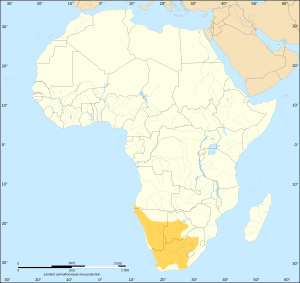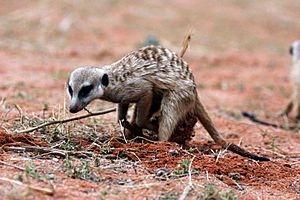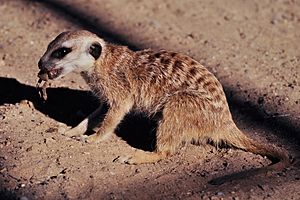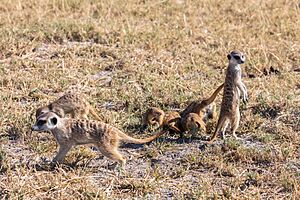Meerkat facts for kids
Quick facts for kids Meerkat |
|
|---|---|
 |
|
| Conservation status | |
| Scientific classification | |
| Kingdom: | |
| Phylum: | |
| Class: | |
| Order: | |
| Family: | |
| Genus: |
Suricata
Desmarest, 1804
|
| Species: |
S. suricatta
|
| Binomial name | |
| Suricata suricatta (Schreber, 1776)
|
|
 |
|
| Meerkat range | |
A meerkat (Suricata suricatta) is a small mammal that lives in the Kalahari Desert in southern Africa. It is part of the mongoose family. A group of meerkats is called a "mob" or "gang". Most meerkats in a group are relatives.
Contents
Meerkat Life and Habits
Meerkats live in burrows under the ground. They are active during the day, but they rest when the afternoon sun is too hot. They live in large family groups. A female and a male usually lead the group.
Meerkats help each other by cleaning fleas from each other's fur. This is called "grooming" and helps them become friends. If a younger meerkat is in trouble with the leader, it might groom the leader to calm them down.
When the family is eating or playing, one meerkat acts as a guard. This guard looks out for animals that might hurt them. If the guard sees danger, it makes a special chirp. Then, the whole group runs to a burrow to be safe.
Young meerkats, called pups, are cared for by older members. These older meerkats babysit the pups at the burrow to keep them safe. Sometimes, a female meerkat who has never had babies will even make milk for the pups.
Meerkats can share their burrows with other animals. These can include other types of mongooses or ground squirrels. Sometimes, even a snake might share a burrow with a meerkat!
Meerkats use many different chirps. They have special sounds for being friendly, for showing anger, and for warning others about danger.
What Meerkats Eat
Meerkats mostly eat insects. But they also enjoy lizards, snakes, spiders, birds, plants, eggs, and other small mammals. Meerkats are like other mongooses because they are not harmed by some venoms. This means they can eat scorpions (even their stingers) and some snakes without getting sick.
Meerkats do not store much body fat. So, they must look for food and eat every single day.
When the meerkat group is eating, a guard meerkat stands tall. It watches for any animals that might try to eat its family. If the guard sees danger, it gives a loud chirp. The family then runs to a hole to hide.
Many animals hunt meerkats. Most eagles, hawks, and falcons will try to catch them. Baby meerkats are sometimes eaten by snakes. Larger meat-eating animals, like Jackals, also sometimes hunt meerkats.
When pups are looking for food, they might cry loudly. An adult meerkat will then come and feed them.
The Meerkat Body
A meerkat weighs about one and a half pounds. It is usually ten to fourteen inches long. Meerkats use their tail to help them balance. This is important because they often stand on their back legs to look for danger.
They have black patches around their eyes. These patches help to reduce the bright sunlight that goes into their eyes. Meerkats have long claws. These claws help them dig burrows and fight if needed.
The back of a meerkat is furry and has stripes. These stripes help them blend in with their surroundings, making it harder for predators to see them. Their front side is black and has less fur. This helps them get warm in the morning sun, so they are ready for the day.
Meerkats also have ears that can open and close. They close their ears to keep sand out when they are digging in the ground.
Meerkat Reproduction and Family Life
Meerkats can start having babies when they are about one year old. A female meerkat can have one to seven babies at a time. Four babies are the most common number.
Meerkats can give birth any time of the year. But they prefer to have babies in spring and summer. This is because there is more food available then. A female meerkat can have up to three groups of babies in one year.
When baby meerkats are born, they are pink and have no hair. Their eyes and ears are closed. When they are three weeks old, their mother lets them leave the burrow. By this time, their eyes and ears have opened, and they have light brown fur. The babies cannot be left alone. So, another meerkat from the group, besides the mother, stays behind to watch them.
After the mother and father mate, the babies grow inside the mother for about eleven weeks. Then, she gives birth in a burrow. She feeds the babies milk until they are about one month old. At this age, they start looking for food with the rest of the group.
The group is led by a female and her mate. This leading pair usually does not let other meerkats in their family have babies. If another female does have babies, the leader might kick her out of the group. Sometimes, the leader might even harm the new babies. Most meerkats in a group are either the leader's brothers, sisters, or children.
New meerkat groups form when a female is kicked out of her old group. She then finds a male and starts a new family with him.
Where Meerkats Live
Meerkats live in southwestern Botswana, western and southern Namibia, and northern and western South Africa. They also live a little bit in southwestern Angola. They like areas with rocky ground and open spaces. These places have little woody plants and are often dry.
You can find them in savannahs, open plains, and rocky areas near dry rivers. They live in places like the Fynbos and the Karoo, where it rains less than 600 millimeters (about 24 inches) each year. In some parts, it rains only 100 to 400 millimeters (about 4 to 16 inches) a year.
Meerkats prefer areas with short grasses and shrubs. They are not found in true deserts, mountains, or forests. The number of meerkats in an area can change a lot. This depends on how much it rains and how many predators are around. For example, if there is less rain, the number of meerkats can drop a lot.
Threats to Meerkats
Meerkats are listed as "Least Concern" by the IUCN Red List. This means they are not currently in danger of disappearing. Their numbers seem to be stable.
The main threat to meerkats is low rainfall. Not enough rain can cause entire groups to die. Very hot temperatures can also be bad for meerkats in the Kalahari Desert. When it's very hot, young meerkats might not survive as well or grow as big. This could be because they lose too much water or their food has less water. It also costs them more energy to stay cool.
Meerkats live in several protected areas. These include the Kgalagadi Transfrontier Park and the Makgadikgadi Pan. The Kalahari Meerkat Project is a long-term research project. It helps scientists understand how meerkats work together in groups.
Meerkats in Culture
Meerkats are generally calm animals. However, they are not good pets. They can be aggressive and have a strong smell. In South Africa, people sometimes use meerkats to control rodents in homes and insects on farms.
Meerkats can pass rabies to humans. But another animal, the yellow mongoose, is more likely to spread rabies. Some people think meerkats might even help stop rabies. They do this by chasing yellow mongooses out of their burrows. Meerkats are usually not hunted because they help protect crops. But sometimes they might be killed if there are efforts to control rabies by getting rid of yellow mongooses. Meerkats can also spread diseases carried by ticks.
Meerkats have appeared in many movies, TV shows, and other media. A famous example is Timon from the Lion King movies. He is a meerkat who acts like a human. Meerkat Manor (2005–2008) was a TV show about meerkat groups in the Kalahari. These meerkats were part of the Kalahari Meerkat Project. Meerkats also lived on a strange floating island in the 2012 movie Life of Pi.
Images for kids
-
Calls of meerkats (above) and banded mongooses (below)
See also
 In Spanish: Suricata para niños
In Spanish: Suricata para niños










